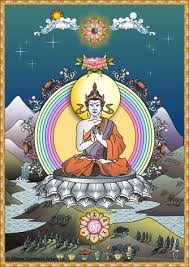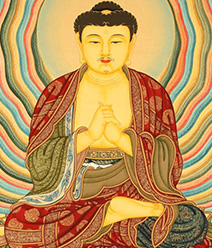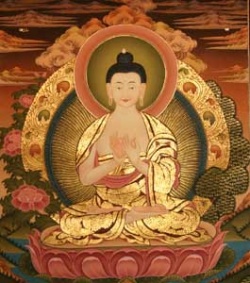Difference between revisions of "Tantric Reading for Done for Class"
(Created page with "<poem> By Al Jigong Billings I finished working my way through Giebel's translation of the Susiddhikara Sutra this evening. I'd already read the Vairocanabhisambodhi S...") |
|||
| Line 1: | Line 1: | ||
| + | [[File:I564es.jpg|thumb|250px|]][[File:Klei rocana.jpg|thumb|250px|]][[File:M Vairoc1.jpg|thumb|250px|]] | ||
<poem> | <poem> | ||
By Al Jigong Billings | By Al Jigong Billings | ||
Latest revision as of 07:20, 11 November 2013
By Al Jigong Billings
I finished working my way through Giebel's translation of the Susiddhikara Sutra this evening. I'd already read the Vairocanabhisambodhi Sutra in my class.
These two texts are actually tantras, not sutras, despite the titles, which I gather is an issue with their propagation in China during the T'ang Dynasty. These are both the translations from the Chinese used in Japan, not the Tibetan versions.
Both of these, along with the Vajrasekhara Sutra (also misnamed), are core texts for the esoteric Buddhist tradition in Japan. Shingon emphasizes the Vajrasekhara and Vairocanabhisambodhi Sutras primarily but Tendai sees the Susiddhikara Sutra, brough back by Ennin, as being a third text unifying the two.
One thing that I noticed is that, really, the Susiddhikara Sutra is largely a ritual manual. It contains very little discussion of anything outside of descriptions of ritual timing, how to construct mandalas, mantras, etc. Unlike the Vairocanabhisambodhi Sutra, it also contains no explicit discussions of mudras (the Vairocanabhisambodhi Sutra has about 30 pages of mudra descriptions, ad nauseum).
One complication is some of the terminology that Giebels uses in his translation:
When Giebel translates the descriptions of how to physically draw out mandalas, he mentions the "insignias" of deities and their placement. I'm not sure what term he is translating as "insignia." I'm assuming it is the bija, seed syllable, of a deity, but I could be wrong.
Giebel constantly translates a term as "Effectuation" or "effectuating", etc. (WTF?) This is in the context of an "article" to be effectuated in a mandala via rites. I'm trying to figure out what, exactly, he is meaning by this (as he used "irradiating" for charging something with mantras so that it radiates power, teja). It seems like some sort of talismanic consecration but...
Part of why the Susiddhikara Sutra is important is that its structure, with three Buddha families, and its mantras, are used in core Tendai esoteric rituals. The Shingon equivilants of these rituals, from the texts that I have, don't use the same structure at all but, instead, draw from the Vairocanabhisambodhi Sutra. This makes these texts relevant in practical terms in that people, today, are still practicing rituals deriving from them in a fairly direct manner.
I am doing a paper for the graduate class that I'm taking (not even as part of a degree program) that is due in about three weeks. I'm going to be discussing the history of these two texts, briefly, along with their importance and then summarizing the ritual contents of the two and attempting to compare them to one another. The vagueness of much of the ritual activity described is not terribly helpful but it is as it is.
This is what I do for fun when not shipping security releases of Firefox, it seems. I'm actually looking forward to this term being over because I want to take the Neophyte ritual of the Hermetic Order of the Golden Dawn, as well as a couple of their other rites, and try using the ritual syntax method of diagramming rituals to diagram those rites. This is the same system that Dr. Payne, who is teaching my course, has used to diagram both the Shingon rituals, such as the Juhachi-do and Goma, but also two different Ajikan rituals. It seems worth the attempt to see how it applies to Western Esotericism, the field of my Master's degree, and maybe I can get a paper published out of it. I have hardly the time to even think about it right now though.
Update: Dr. Payne wrote to me in answer earlier (to a query from me) on the first issue. He stated that he thought that by "insignia", the text is probably meaning the items found in a karma mandala, such as things like a five-pointed vajra, or a vase with a single lotus flower, each of which represents one of the deities or other elements of the mandala arrangement. He mentions that these are often discussed as sculptural, three dimensional representations, but he has seen them drawn or painted.


